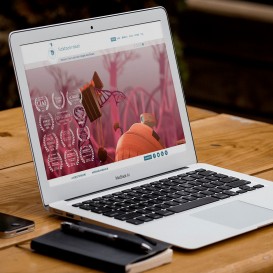Web copywriting made simple
The web copywriting challenge
We read a web page in a different way to the way we read the printed page. That’s a fact. Web visitors expect a more immediate and personal relationship with the words that appear on a page. Web copywriting has two main goals: to keep visitors reading and to convert them into action at the end.
We scan, rather than read, a web page
Study after study has shown that we do not read a web page in the same way that we read a printed page. We scan rather than read it. This means that copy written for books or brochures is not going to translate directly onto a website. Those glossy corporate communications may look tempting to use, but they are not going to provide you with copy that you can effectively lift straight onto your website. It’s just not that simple: and here’s why.
Usability researchers have found that the eye scans a website looking to quickly gain information. Typically we scan in an F-pattern:
• We focus on a couple of sentences at the top of the page
• Our eye trails down the left side
• We also quickly glance at a few lines near the middle
![]()
Source: Nielsen Norman Group
In the examples above you can see how the product page (centre) and the search engine results page (right) are structured with broken up text that aids this scan. The corporate page (left), with its large chunks of unbroken text, simply leads to shut down with large sections left unread.
So what does this mean for you?
Serving the scan #1: Bullet points
Bullet points (or numbered lists) are perfect for:
- Breaking up blocks of text
- Making key points simple to scan and easy to digest
- Keeping everything to the left of the typical F scan
Bullets can be used for:
- Short key points
- Longer sentences - can also work for bullets. Just use a heading in bold to help clarify exactly what the longer text that follows is about
If you can say it in bullets, do so. You won’t be shooting yourself in the foot.
Serving the scan #2: Short paragraphs
Another great way to provide those breaks is by keeping your paragraphs short. The breaks between each section help tell the eye where a new section, and new information, begins.
Of course, this only works if you make sure each paragraph leads with your main point.
Make sure you say it upfront: the web is not a place to tease the reader with the promise of a later revelation. You can read more on this in Serving the scan#6: The front line
Serving the scan #3: Use images and videos
Images or videos support your copy in a number of ways:
- They help break copy up
- They offer a useful way to get ideas across visually
- They also give your page more reasons to be returned on search pages
Serving the scan #4: Formatting
The scanning eye will immediately be arrested by text that is formatted differently.
You can use bold to make things stand out, use italics to do the same or even underline key words to highlight them.
Serving the scan #5: Headings
Headings are important to guide the web page reader’s scan, and to pique their interest.
Headings and sub-headings are usually:
- Formatted differently
- In a larger font size
- Separated from body copy by a line break
This means they are perfect for arresting attention and directing the scanning eye. Make sure you use headings to regularly demarcate sections of your copy.
You can make headings count even more by making sure they not only inform but also intrigue.
The following tried and tested techniques are guaranteed to get attention from the very start for any blog post or web article.
- Direct headings go straight to the heart of the matter, with no beating about the bush - Free water saving device
- Indirect headings use curiosity to engage - The cistern system that saves you money
- News headings are not about world affairs but announcements focussing on something new - The latest water saving device now available
- 'How to' headings work like a charm - How to save water and save money.
- Question headings must ask a question your audience can empathize with or would like to see answered - Could you slash your water bill by 29%?
- Command headings tell the audience what to do
Get a water saving device and start saving money - Reason why headings introduce numbered tips or reasons in the copy - 8 ways our water saving device is good for you and the planet
- Testimonial headings offer a highly effective way of presenting outside proof that you offer great value - ‘I use this water saving device, so should you,’ says M Jones
Serving the scan#6: The front line
Source: http://www.marketingfacts.nl/berichten/copywriting-voor-e-commerce-schrijvend-naar-meer-omzet
Speaking about getting their attention, here’s something to always bear in mind (and we’ll say it loud):
Subtlety is
for poems
not for websites
Consider this:
5 trillion—the number of internet pages that Google has indexed.
50%—the average bounce rate for websites (which means that about half of the people who land on a page on your website take one look at it, leave and don't come back).
With so many competing pages, and such a demanding audience, you need to hook their attention fast. You need to communicate why your page is important in an instant.
Get to the point quickly and make sure you start selling it straight away.
Now consider these competing paragraphs trying to get their point across:
Your main point here. Lorem ipsum dolor sit amet, consectetuer adipiscing elit. Aenean commodo ligula eget dolor. Aenean massa. Cum sociis natoque penatibus et magnis dis parturient montes, nascetur ridiculus mus. Donec quam felis, ultricies nec, pellentesque eu, pretium quis, sem. Nulla consequat massa quis enim.
Lorem ipsum dolor sit amet, consectetuer adipiscing elit. Aenean commodo ligula eget dolor. Aenean massa. Cum sociis natoque penatibus et magnis dis parturient montes, nascetur ridiculus mus. Donec quam felis, ultricies nec your main point here pellentesque eu, pretium quis, sem. Nulla consequat massa quis enim.
Which one conveys your main point clearly, quickly and effectively?
Finally, consider these tips for focussing on the front line:
- Before you sit down to write be clear about the key takeaway that you want visitors to have after they visit your page
- Highlight your key takeaway in a bold font, especially if it isn’t in the very first sentence
- Make sure your most important points feature on the first viewing of your page (above the fold), as sub-headings, as the first sentences of paragraphs and as bullet points
Serving the scan#7: Accessible, simple language
It’s not just subtlety that does you no favours on the web.
Flowery language and convoluted sentences are also not designed for the scanning eye.
Say it simply.
Keep your sentence length down.
Keep rhetorical devices for the courtroom or be judged by the unforgiving metrics of a high bounce rate.
Writing web copy that converts
It’s not all about the scan.
Now you have their attention, and they are reading copy written for the web environment, you need to convert them.
- To buy
- To read more
- To subscribe
- To call
- To come back
In short, to do whatever it is that you have created your website for. Next we are going to look at ways to make your web copy convert your visitors into customers.
Copy that converts #1: The long and short of it
The need for web copy to be clear and concise has led many to assume that it must be short. You’ll often read pundits claiming that 300 words is the optimum length for a web page. Another misguided word of wisdom is that web copy should be about half the length of that intended for print.
We beg to differ.
- Google, in its never-ending quest for authoritative content, is expecting to see web pages that average at least 600 words across your site
- There are many types of pages and audiences that demand longer content
- Studies have shown that longer pages can be more effective at converting visitors than the classic short web page
As long as your writing is clearly structured, formatted correctly and written in a way that is easy to digest, you will not lose your visitors simply by having longer pages.
Here are some circumstances that demand a longer page.
- Certain products—the more features and benefits a product or service has, the longer the copy needs to be. Likewise the more innovative the proposition is, the longer the copy needed. Or the more expensive the product, and so on...
- Certain audiences—a highly specialised audience will ask for more detailed information. Likewise someone further down the buying cycle will need more product or service information, and so on...
- Certain goals—generating a lead for a service business requires less detail than converting a sale for a service business. Likewise getting someone to download a free app requires less copy than getting someone to invest in the development of an app, and so on...
When deciding on the length of your copy you should think long and hard about your audience, buying cycle, product or service and about your goals. It is this that will determine just how much information and copy you need.
See the section below on Links for how you can use hyperlinks to offer extra information for those who need it, without compromising your page for others.
As well as understanding your audience, you also need to be prepared to question your assumptions. The received wisdom is that to convert web visitors we must cut copy down to its bare minimum, stripping it away of all surplus information. Yet, there have been many studies that give the lie to this and give the thumbs up to longer copy.
The long and short of it is that only conversion testing will tell you what works best for you. The proof, after all, is in the pudding.
Copy that converts #2: Benefits and experiences vs features
It’s so easy to think inwardly. But it’s a trap.
You spend all your time dealing with your company, its products and its services. You’re really proud about what you do, and it’s only natural that you want to tell the world about what great things your company does.
But no-one else wants to hear it.
Your visitors don’t want to know about how great your company is: they are too busy searching for ways to make life better for themselves.
Here’s the main question that every visitor to a web page comes with:
What’s in it for me?
Go back and read your web copy. Is it about you or does it clearly spell out just what you can give to your visitors?
Let’s put it to the scales.
The typical web page weighs in like this:
80% features 20% benefits 0% experience
A more effective web page would weigh in like this:
20% features 30% benefits 50% experience
It’s not that there isn’t a place for features. There is, usually towards the end of the buying cycle. The start of this cycle, though, is dominated by considerations of the experience. It’s all about me.
To bring this to life:
- The feature of a news reader app may be that it contains an artificial intelligence algorithm
- The benefit of this is that it makes the feed more personal as it adapts and customises the user’s information
- The experience of this is that by keeping the things I read the most at the forefront, I can stay up to date with the things that matter most to me, and kiss goodbye to information overload
To drive the point further home:
It’s not about what you do. It’s all about what they get.
Copy that converts #3: Active voice
When writing web copy always opt for the active voice: it makes everything so much more powerful, immediate and personal. Which is to say, it’s so much more effective.
Here’s an example:
We wrote our new book to help you work smarter, not harder.
Now compare this to:
The new book written by our company can help you work smarter instead of harder.
When you use the active voice, the subject does the action instead of being acted upon. This makes it powerful. Sentences that follow this structure are easier to understand, convey movement and are more directly interesting to the reader.
Copy that converts #3: Links and immediacy
The web is an immediate environment. By this we mean that people expect to do things immediately. They expect to find the information they want, buy the products they want or see the images they want. Right now.
It is important to remember this need for immediacy when creating content. Links are a great way to offer this as they provide an immediate way to move from one web page to another.
Here’s how links can make or break your copy and content:
- Carefully chosen external links out from your site can position you as an authority on a subject area
- Internal links can help build the importance of internal pages in the eyes of search engines
- Internal links can help move your visitor along the buying cycle
- Internal links can help you offer more detail without overloading a page
- Internal links can encourage visitors to explore more of your website
- A well-placed internal link can help direct a visitor to a related but more directly relevant page on your website
Even the best web copy falls flat on its face without strong calls to action. There is absolutely no chance at all of your horses drinking if you are not even leading them to the water.
Web visitors want you to make it crystal clear if you are expecting them to do something. If it is not they invariably leave. They are not going to think about what they need to do next. It’s easier to go somewhere else.
Let’s think about the sorts of things you might want a visitor to do:
- Place an order
- Enrol or subscribe
- Make contact offline (by phone or email)
- Get a quote
- Learn more
- Join your social media network
You need a call to action on every page. These calls to action can be text-based, image-based or, better still, both.
Different pages will need a different call to action. Introductory, high-level category pages normally suit a softer goal (‘Request more information’ or ‘Ask for a call back’). For more detailed product pages you need a harder goal (‘Order now’).
It can be worth having both a softer and a harder call to action on the page. After all an email address may well lead to a sale at a later date.
Calls to action should not beat around the bush but adding a benefit to them helps their effectiveness:
- Order now and save 15%
- Get your prints within 24 hours
- Discover the 7 secrets of beautiful skin
Calls to action can also be more effective if they are surrounded by supporting information. This could include:
- Testimonials—from other customers
- Credibility proof—awards, tests, recognition
- Warranty or guarantee—reducing perceived risks
- Benefit restatement—reminding of the reasons it’s worth having
- Urgency—reasons to act now
Our call to action
Understanding how your visitors will read (or scan) your web pages is the first rule of successful copywriting. The second is giving them what they want, not what you want.
Web copywriting need not be a headache. But should it prove so, Nexus has a dedicated team of copywriters waiting to convert your visitors into customers.



